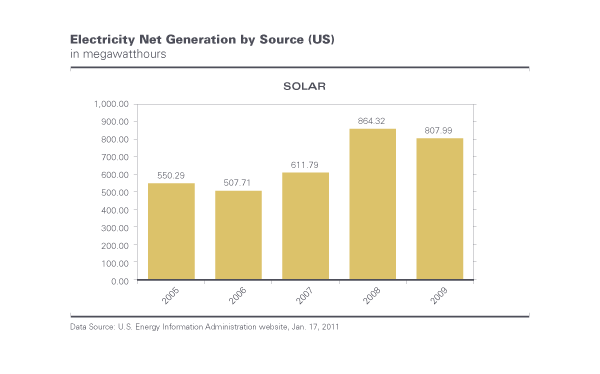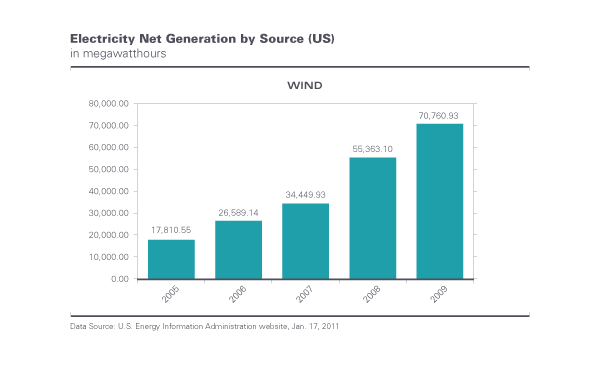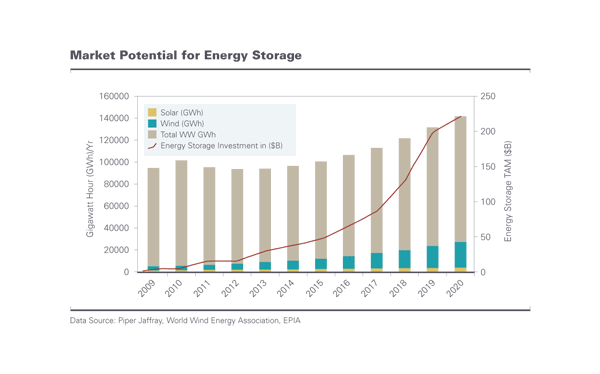Renewable energy supplies such as wind and solar continue to emerge while meeting an increasing percentage of today's electricity demands.1
But yesterday's grid was never designed to handle the intermittent power supplies these clean energies represent; simply put, we can't expect the wind to blow or the sun to shine based on when or how much electricity we need.
The easiest and most cost-effective solution is to store whatever renewable energy is created, and then release it to the grid at the optimum time to avoid both shortfalls and overloads.
Fortunately, the unique properties of vanadium make this, and other critical energy storage solutions, possible through Vanadium Redox Batteries (VRBs). As VRB solutions continue to be developed and implemented, new demand for vanadium is expected to raise the overall consumption of this critical element.2
The Need for Energy Storage
According to the U.S. Energy Information Administration (EIA), net electricity generation from all forms of renewable energies in America increased by over 15% between 2005 and 2009.
While output from renewables such as hydroelectric and biomass remained basically flat during that period, solar and wind made significantly disproportionate market gains:
- Solar net electricity generation gain: 46.8%
- Wind net electricity generation gain: 297.3%1
These early market gains will only be expanded upon in the years to come. But more wind and solar generated electricity also means less compatibility with the existing grid, which was designed to generate electricity as needed and to consume it instantly.
Which is why the Institute of Electrical and Electronics Engineers (IEEE) stated in their 2009 National Energy Policy Recommendations:
"If intermittent sources of electric power, such wind and solar, are to reach their full potential to contribute to the nation's power requirements, technologies for large scale energy storage must be developed and deployed." 3
The Type of Storage Needed
Multiple energy storage market segments exist – load leveling, peak shaving, uninterruptable power supply (UPS) for hospitals and nuclear reactors, remote/off-grid power systems, and more – each with its own set of requirements.4
At a high level, however, some common requirements for mass energy storage batteries include:
- ability to scale large enough to pull a given power supply through a rough patch
- ability to be charged and discharged repeatedly over a very long period
- ability to release large amounts of electricity rapidly
Unlike lithium-ion batteries, Vanadium Redox Batteries (VRBs) meet all these requirements. By combining VRBs with renewables such as wind and solar, the goal is to convert an inherently intermittent energy supply into what the industry refers to as 'dispatchable' electricity.
Dispatchable electricity – such as that from fossil fuel or nuclear power plants – can be regulated from moment to moment, allowing the grid to balance the amount of energy being put into the wires with the demand arising from consumers.5
– Imre Gyuk, manager of energy systems research
at the U.S. Department of Energy 5
Energy Storage Funding and R&D
In June 2010, the U.S. Department of Energy's (DOE) Office of Electricity stated its goal of increasing energy storage capacity 10-fold to improve grid reliability and facilitate the adoption of such variable and renewable generation resources as wind and solar.
In turn, the office requested a $40 million budget for 2011, up 186% from their 2010 budget of $14 million, which was 288% higher than their 2009 budget.
The monies will help support the energy storage R&D focus on grid-scale applications, including reducing the costs and enhancing the capabilities of battery technologies.
In total, the U.S. government has set aside $185 million to invest in deploying and demonstrating the effectiveness of utility-scale grid storage systems.6
Dwarfing that investment is the ~$600+ billion in spending on energy storage solutions that is expected over the next 10-12 years, reaching $200+ billion in 2020 alone, according to a February 2009 report by Piper Jaffray.7
Current VRB Applications
More companies continue to enter the emerging Vanadium Redox Battery market. As of early 2011, some of the manufacturers include U.S./China-based Prudent Energy; U.S.-based Ashlawn Energy; Austria-based Cellstrom GmbH; Thailand-based Cellenium (Thailand) Company; and UK-based RedT (Renewable Energy Dynamics Technology Ltd.).
As of January 2011, Prudent, in particular, announced it had installed over 20 energy storage systems worldwide in response to increased demand and repeat orders.
At that time, 2 of those systems had operated for over 3 years at remote telecom sites with "superb results," including reducing diesel fuel usage by over 65%.
Other Prudent installations include several U.S. and China-based renewable energy storage systems that support the power grid through load balancing, and by smoothing the power output from solar and wind energy sources.8
Meanwhile, there have been 8 VRB installations in Japan ranging in size from 100kW to 4MW. These installations have provided peak-shaving, solar and UPS applications, and the first large-scale wind farm integrating energy storage, which was cycled over 270,000 times over a 3-year period.8
Potential VRB Applications & Demand
In October 2008, Cellstrom installed what was hailed as the first solar-VRB powered filling station for electric vehicles.9
Located at an Italian vineyard, the application represents just one of multiple power solutions ideally supported by VRBs: remote telecom sites (like the 16 Prudent has installed in Kenya),8 electricity supply for on- or off-grid households/communities, and even electric vehicles, as pointed out by European research giant, Fraunhofer-Gesellschaft.
Fraunhofer explains that since VRBs store their electricity in a vanadium-based fluid (i.e., the battery's electrolyte), a VRB-powered vehicle low on charge could simply exchange its discharged electrolyte for charged electrolyte at a gas station as easily as filling a gas tank.
As of October 2009, Fraunhofer had managed to increase the mileage of VRBs in test cars by four or five-fold, to approximately that of lithium-ion batteries.10
As these and other VRB-based critical energy storage solutions continue to be developed and utilized, the demand for vanadium will continue to grow.
According to a Q4 2009 report by Byron Capital Markets, new market demand for vanadium is projected to combine with conventional demand (primarily from the steel industry), resulting in an overall demand increase of over 70% between 2009's levels and those of 2014.2
1. U.S. Energy Information Administration website, Jan. 17, 2011
2. Vanadium: The Supercharger. Byron Capital Markets report, Nov. 12, 2009
3. IEEE National Energy Policy Recommendations, Jan. 2009
4. Vanadium Market Fundamentals and Implications (Terry Perles/TTP Squared, Inc. presentation), Nov. 16, 2010
5. The Element That Could Change the World. Discover Magazine, Sept. 29, 2008
6. Energy Storage R&D at the U.S. Department of Energy (presentation), June 28, 2010
7. The Metamorphosis of Flow Batteries (presentation delivered at the International Flow Battery Forum conference, Vienna, Austria), June 16, 2010
8. Prudent Energy website, Jan. 17, 2011
9. Cellstrom GmbH website, Jan. 18, 2011
10. Fraunhofer-Gesellschaft website, Jan. 17, 2011




